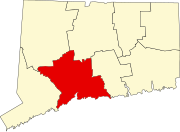Orange, Connecticut
[2] When originally settled by English colonists, Orange was the northern and eastern district of the now neighboring city of Milford; however, by 1822, the population of the area had grown to the point where residents desired to form their own separate community, thus forming the town of Orange.
It was not until 1921 that the two were officially separated by act of the Connecticut General Assembly and the new city of West Haven was formed out of the southeastern portion of Orange.
[4] This left Orange a largely rural town, as the bulk of the urbanized population was ceded to West Haven.
The advent of a trolley from New Haven to Derby (starting in 1904 and running until 1937) hastened the end to rail service (in 1925).
[5] Later, the construction of the Wilbur Cross Parkway and Interstate 95 brought highways through the area.
Orange station is a planned stop on Metro-North Railroad's New Haven Line.
[11][12] It is also the home of the headquarters of Avangrid and its subsidiaries Southern Connecticut Gas[13] and The United Illuminating Company.
[15] Orange was the home of the US headquarters of Saab-Scania from 1972 until 1992 when the company relocated to Norcross, Georgia.
[17] In 2013, the University of New Haven purchased the former Hubbell headquarters buildings to redevelop as a graduate school campus.
[18] Yale's West Campus is located on the Orange-West Haven town line, on a 136-acre property that was formerly occupied by Bayer.
[20] Field View Farm, one of the oldest businesses in the United States, has been operated by the Hine family since 1639.
[20] During the Cold War, Orange was a location for the permanent deployment of Nike missiles for the defense of Greater New Haven.
It has continued since then featuring horse, oxen and tractor pulls as well as exhibits of animals, flowers, fruits, vegetables and baked goods.
Orange was the site of one of the earliest computer camps,[27][28] held at the local Amity Jr. High School in 1977.



